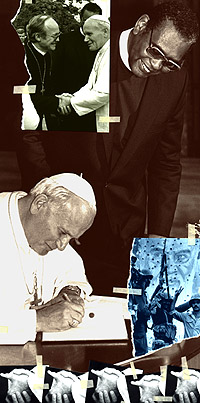In 1928 an encyclical letter from the pope suggested that the only appropriate path to church unity was the return to the Roman Catholic Church of Christians separated from it. Ten Catholics were invited as observers to the first assembly in Amsterdam in 1948, but the Vatican did not allow them to attend.
No
Many local, national and regional ecumenical bodies now include the Catholic Church among their members; and many WCC member churches have been engaged in official theological dialogues with the Catholic Church.
Careful discussions in the early 1970s led the Roman Catholic Church to decide against membership in the World Council of Churches, but there is ongoing collaboration between the two in many areas, notably in the Faith and Order commission.
Official visits to the Geneva offices of the WCC -- by Pope Paul VI in 1969 and by Pope John Paul II in 1984 -- have made visible both the promise and the difficulties of relations between the Council and the Roman Catholic Church.
The Decree on Ecumenism suggests that surmounting obstacles to church unity requires more than study by theologians and negotiations among church leaders:
ecumenism
without
conversion
All this changed with the Second Vatican Council (1962-1965). Its Decree on Ecumenism became the charter for Roman Catholic engagement in the ecumenical movement.
There can be no ecumenism worthy of the name without interior conversion. We should therefore pray to the Holy Spirit for the grace to be genuinely self-denying, humble, gentle in the service of others. This change of heart and holiness of life, along with public and private prayer for the unity of Christians, should be regarded as the soul of the whole ecumenical movement.

Moving clockwise from the top left, the images are 1 & 2: Geneva, 1984: Pope John Paul II visits the World Council of Churches (Peter Williams/WCC); 3: Baghdad, Iraq, 1988: Iraqi soldiers in front of a portrait of Iranian leader Ayatollah Khomeni (Charles Platiau/Reuter).